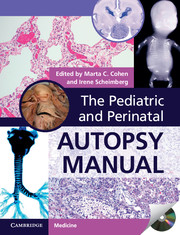Book contents
- Frontmatter
- Contents
- List of contributors
- Foreword
- Preface
- Acknowledgments
- 1 Perinatal autopsy, techniques, and classifications
- 2 Placental examination
- 3 The fetus less than 15 weeks gestation
- 4 Stillbirth and intrauterine growth restriction
- 5 Hydrops fetalis
- 6 Pathology of twinning and higher multiple pregnancy
- 7 Is this a syndrome? Patterns in genetic conditions
- 8 The metabolic disease autopsy
- 9 The abnormal heart
- 10 Central nervous system
- 11 Significant congenital abnormalities of the respiratory, digestive, and renal systems
- 12 Skeletal dysplasias
- 13 Congenital tumors
- 14 Complications of prematurity
- 15 Intrapartum and neonatal death
- 16 Sudden unexpected death in infancy
- 17 Infections and malnutrition
- 18 Role of MRI and radiology in post mortems
- 19 The forensic post mortem
- 20 Appendix tables
- Index
- References
3 - The fetus less than 15 weeks gestation
Published online by Cambridge University Press: 05 September 2014
- Frontmatter
- Contents
- List of contributors
- Foreword
- Preface
- Acknowledgments
- 1 Perinatal autopsy, techniques, and classifications
- 2 Placental examination
- 3 The fetus less than 15 weeks gestation
- 4 Stillbirth and intrauterine growth restriction
- 5 Hydrops fetalis
- 6 Pathology of twinning and higher multiple pregnancy
- 7 Is this a syndrome? Patterns in genetic conditions
- 8 The metabolic disease autopsy
- 9 The abnormal heart
- 10 Central nervous system
- 11 Significant congenital abnormalities of the respiratory, digestive, and renal systems
- 12 Skeletal dysplasias
- 13 Congenital tumors
- 14 Complications of prematurity
- 15 Intrapartum and neonatal death
- 16 Sudden unexpected death in infancy
- 17 Infections and malnutrition
- 18 Role of MRI and radiology in post mortems
- 19 The forensic post mortem
- 20 Appendix tables
- Index
- References
Summary
Background
Examination of fetuses of less than 15 weeks gestation poses problems not encountered in older fetuses. Structures are small, organs may be difficult to find, and also difficult to evaluate. This represents a particular challenge. Also, the approach will differ depending on whether the fetus is a fresh abortus, a macerated intrauterine fetal death (IUFD), or the result of termination of pregnancy (TOP) due to a congenital anomaly and/or chromosome aberration. In all cases it is important to remember that the examination is not complete without the placenta. Ballantyne’s words, “To examine a fetus without its placenta is like going to sea without a chart,” are always valid [1]. This applies particularly to IUFDs, where the placenta is likely to play an important role.
Obstetricians and general pathologists are often not fully aware of the importance of autopsy of even small fetuses. A properly conducted autopsy may have wide consequences for the parents and for the clinicians or geneticists who have the task of informing and eventually counseling the parents on future pregnancies. Most parents will want to know why the fetus died or was aborted, and most of all, they want to know if there is a similar risk in future pregnancies. For the clinician it is more rewarding to talk with the parents when they have concrete information and can explain what happened. In cases where there is need for genetic counseling, the geneticist will benefit from access to external description and detailed photographs.
- Type
- Chapter
- Information
- The Pediatric and Perinatal Autopsy Manual , pp. 47 - 61Publisher: Cambridge University PressPrint publication year: 2000
References
- 4
- Cited by



